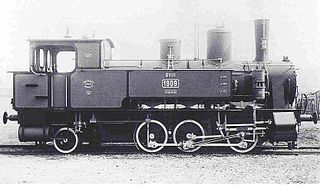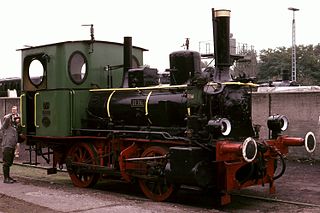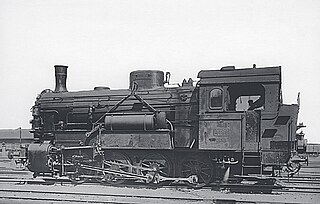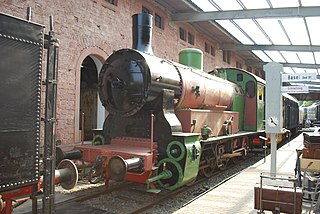
The Bavarian Class D XI engines were branch line (Lokalbahn) saturated steam locomotives built for service with the Royal Bavarian State Railways.
The Bavarian Class D X engines were saturated steam locomotives of the Royal Bavarian State Railways.

The Bavarian Class D VIII were saturated steam locomotives with the Royal Bavarian State Railways.

The Bavarian Class D VI were German, 0-4-0, steam locomotives of the Royal Bavarian State Railways. They were light, twin-coupled, saturated steam, tank engines. Maffei supplied the first 30 locomotives from 1880 to 1883, and Krauss delivered a further 23 up to 1894.
Locomotives 9 and 10 of the Lokalbahn AG (LAG) were saturated steam locomotives that were built for the Murnau - Garmisch-Partenkirchen route opened in 1889.

The Bavarian Class GtL 4/4 engines were superheated steam locomotives in service with the Royal Bavarian State Railways for duties on branch lines (Lokalbahnen).

The Bavarian Class D XII steam locomotives were manufactured by the firm of Krauss from 1897 for the Royal Bavarian State Railways. Ninety six of them were procured for service on the stub lines running from Munich into the mountains, but in reality they were stationed in many large Bavarian locomotive depots. Two engines were transferred to the Palatinate Railway (Pfalzbahn) in 1916, the remaining 94 later joined the Deutsche Reichsbahn fleet and were incorporated as DRG Class 73.0-1 with operating numbers 73 031–124.

The physically identical Palatine and Bavarian Class R 4/4 engines of the Royal Bavarian State Railways were goods train tank locomotives with four coupled axles and no carrying axles. The first nine machines were built for the Palatinate Railway (Pfalzbahn) in 1913 and 1915 as the Palatine Class R 4, the remainder from 1918 to 1925 as Bavarian R 4/4 engines.

The six-coupled P 5 of the Palatinate Railway (Pfalzbahn) was to replace the four-coupled locomotives in the Palatinate. They were given a leading Krauss-Helmholtz bogie and a trailing bogie in order to achieve satisfactory weight distribution.
The steam locomotives of Bavarian Class LE were narrow gauge engines with the Royal Bavarian State Railways.
The Prussian T 13 was a series of tank locomotives built in large numbers for the various German state railways, notably the Prussian state railways, and the Deutsche Reichsbahn during the early part of the 20th century.

Class T 5 of the Palatinate Railway was a German, goods train, tank locomotive class with five coupled axles and no carrying axles.

The Palatine Class L 2 were a group of steam locomotives used on the Palatinate Railway in early 20th century Bavaria. They were built for the line between Speyer and Neustadt an der Weinstrasse. Because the engines were to be used double-headed, they had doors on the front and rear of the driver's cabs and an opening in the running plate. This enabled access to the locomotive from the train whilst running.
The German steam locomotive of Palatine Class Pts 2/2 of the Palatinate Railway was a one-off and was built by the firm of Maffei in Munich. Notable features were the high boiler and the locomotive frame used as a water tank. Coal was carried in two bunkers on the left and right of the driver's cab.
The DRG Class 99.10, formerly the Palatine Class Pts 3/3 H of the Palatinate Railway, was a German narrow gauge steam locomotive. It was the superheated version of the PtS 3/3 N. Unlike the saturated steam version the upper section of these engines was no longer glazed, otherwise they were broadly identical. They could carry up to 2.0 m3 of water and 1.2 t of coal.

The narrow gauge steam locomotives of Palatine L 1 and Pts 3/3 N of the Palatinate Railway were procured for lines in the area of Ludwigshafen, Neustadt an der Weinstrasse and Speyer. On the formation of the Reichsbahn the engines were given the running numbers 99 081 to 99 093.

The German steam locomotives of Palatine Class P 3I were operated by the Palatinate Railway and were the first engines in Germany with a 4-4-2 (Atlantic) wheel arrangement. The two-cylinder saturated steam locomotives with inside cylinders had in addition to an inside bar frame a characteristic outer frame for the rear part of the locomotive, that partly covered the driving wheels. The valve gear was of the Joy type.
The Palatine T 4II was a class of saturated steam, tank locomotives operated by the Palatinate Railway.
The Palatine T 3 was a class of goods train tank locomotives with a C n2t wheel arrangement in service with the Palatinate Railway. They had no running axles. They were incorporated into the Deutsche Reichsbahn as DRG Class 891 with operating numbers 89 101–121. Their design was based on that of the Bavarian D V.











